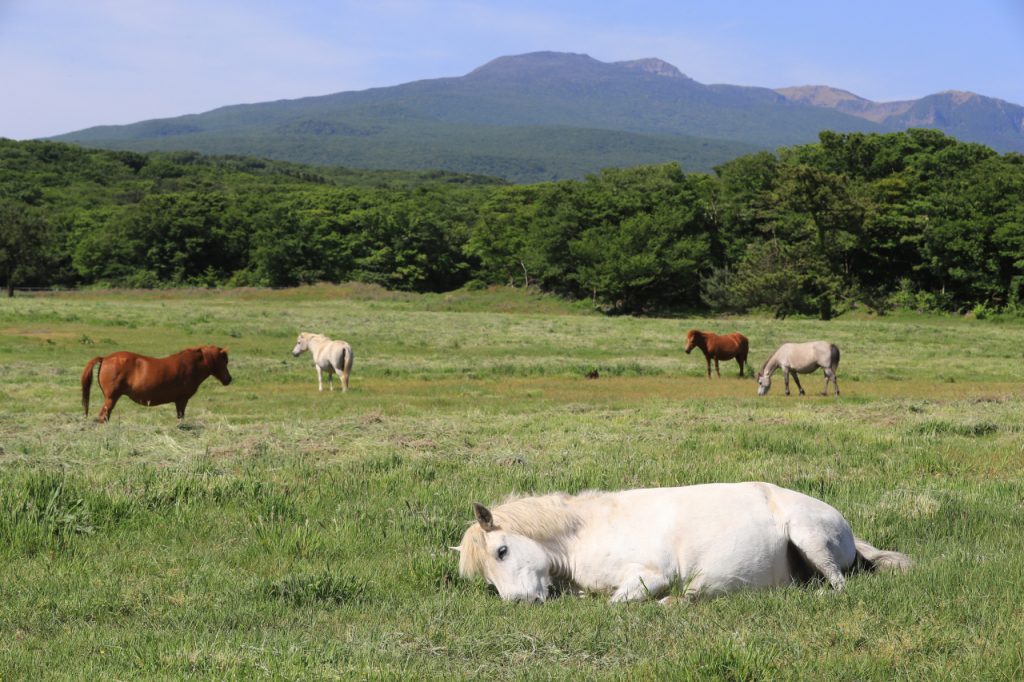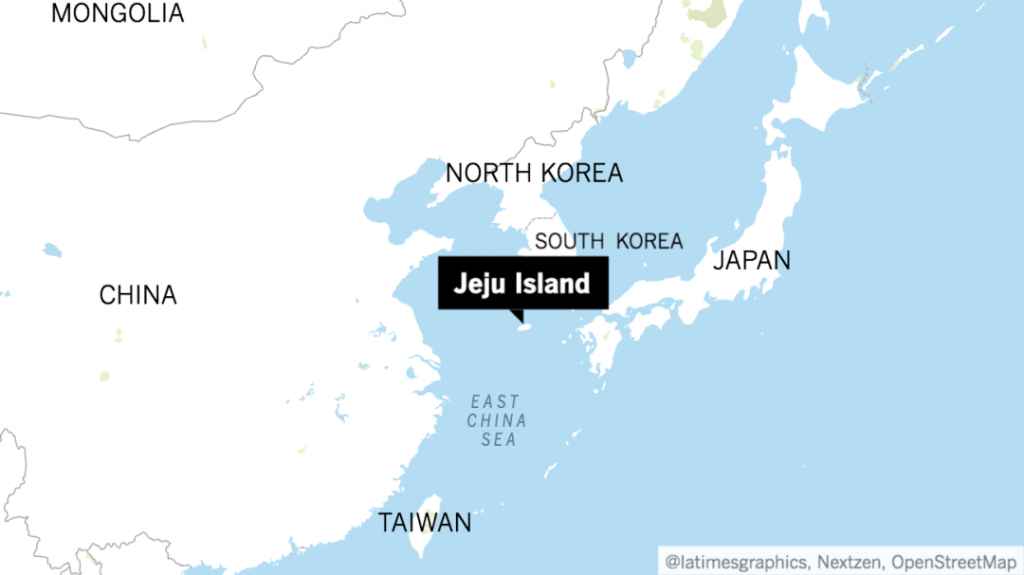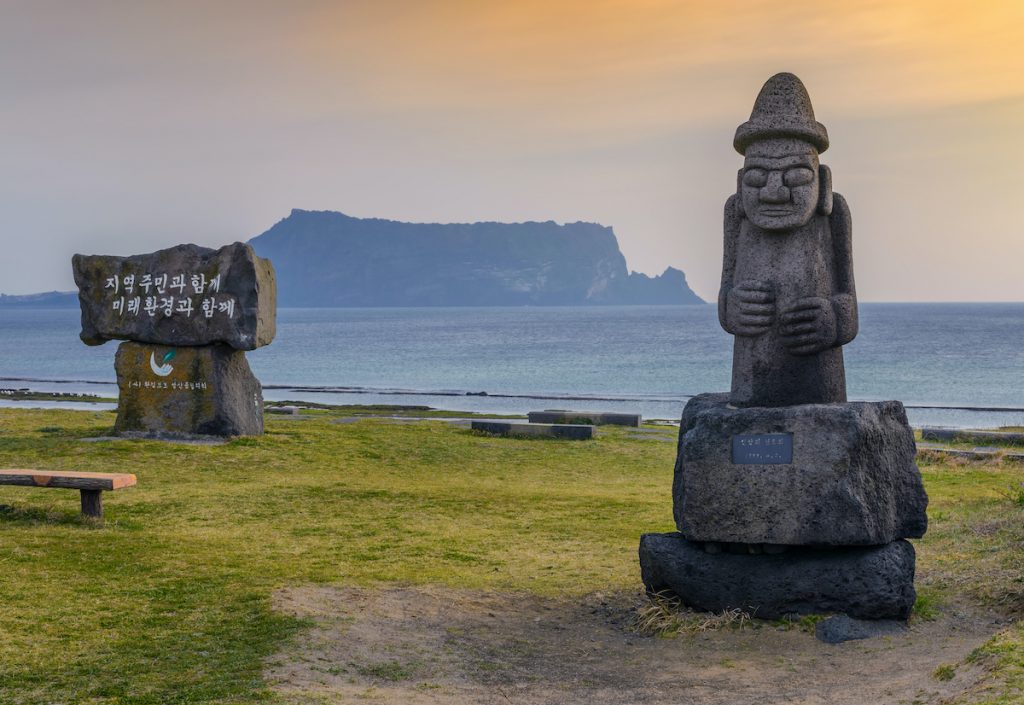The history of Jeju Island is marked by a deep and perpetual endeavor to secure independence. As the largest island in South Korea, its geographic proximity to not just the Korean Peninsula but also China has made it a historical “strategic point [even] from old times” (Task Force of Preparing Investigation Report of Jeju April 3 Incident [TFIR] 2014, 65). Commonly utilized as a stepping stone for linking the military operations across the East China Sea, its people have fought and resisted against powers seeking to maximize its geopolitical significance for centuries. As a result, Jeju Island’s background is essential to understanding the 4·3 Uprising and Massacre that has defined so much of its last 70 years.
Jeju Island, accessed December 21, 2020, Source: Los Angeles Times, <https://www.latimes.com/world-nation/story/2020-11-19/south-korea-china-beijing-economy-thaad-missile-interceptor>
Colonial History
Starting from the 13th century, the Mongols invaded Jeju Island and “ruled it for about 100 years,” using it as a naval stronghold and springboard to attack and invade Japan and southern parts of China (TFIR 2014, 65). As one of the largest empires in history, they had already expanded and maintained their control over most of Asia, though their armada of ships could never successfully overtake major parts of Japan (Szczepanski 2019). When not attempting to colonize Japan, the Mongols used the island to breed their horses with massive ranches, a practice that Jeju is still known for today (Lee 2013).
Jeju horses grazing in a pasture, June 2020, digital photograph, accessed December 18, 2020, Source: Yonhap, <http://m.koreaherald.com/view.php?ud=20200602000756>
Centuries later, the Japanese Empire annexed Jeju Island, along with the rest of Korea, in 1910 as it expanded its territorial claims throughout East Asia. During its 35-year long forced rule of Korea, they also waged a cultural war on the inhabitants, assimilating them with their control over language, labor, land, religion, and education (Blakemore 2018). During the second Sino-Japanese War in 1937, Japan converted the island into an air base to bomb China (TFIR 2014, 65). Just a few years later, Japan further utilized the Jeju island as a “last bastion . . . against the USA to protect the mainland” and fortified its defensive capabilities for WWII (TFIR 2014, 65); through forced labor, the Jeju inhabitants dug tunnels and underground fortresses in the event of an Allied attack (Hyde 2009).
Defensive tunnels dug in WWII on Jeju Island, n.d., digital image, Accessed December 21, 2020, <http://www.jejuweekly.com/news/articleView.html?idxno=161>
Post-WWII History
Thus, following the defeat of Japan, the islanders were already malcontent with foreign intervention as Jeju Island became its own province in August 1946 (TFIR 2014, 96). Seeking self-determination, the Jeju people formed a de facto government that “[functioned] independently of provincial direction” (Park 2010, 362). Though most of the South Korean mainland’s left-wing presence had disappeared and been forced underground, left-wing and right-wing groups peacefully cooperated and pursued moderate policies. The American Military, which had by now established temporary rule over South Korea, even allowed islanders to administer their own affairs and gave them its “wholehearted support,” describing Jeju Island to the U.S. Congress as a “truly communal area that is peacefully controlled . . . without much Comintern influence” (Park 2010, 362).
U.S. Military Government in Korea and its flag, May, 1948, The Jeju 4·3 Incident Investigation Report (Revised Translation) Source: The U.S. National Archive and Records Administration.
Although this period of coexistence was eventually disrupted by the Jeju people’s anti-American and pro-independence March 1st demonstrations, the U.S. and ROK’s treatment of the villagers’ freedoms is just as susceptible to blame. The post-WWII years leading up to the uprising likely triggered their familiar experiences and memories of being invaded and held hostage to extraterritorial demands. For example, in 1947, the South Korean president even offered a permanent naval base on Jeju Island, an unacceptable proposal for its inhabitants, to the U.S. (TFIR 2014, 66).
Furthermore, the U.S. scheduled elections for only South Korea, excluding North Korea, on May 10 1948. The Jeju people, desiring a unified Korea, only grew even more resentful of the U.S. influence on the election and Korea’s future. Eventually, their provincial government, which had peacefully operated and managed left-wing, right-wing, and American interests, was challenged and overthrown in the wake of the police shootings of March 1, 1947 (TFIR 2014, 128).
Today
Only by understanding the Jeju 4·3 Uprising through the anti-colonial lens of the islanders can one better understand the disaster. The uprising simply represented a unified movement by the people of Jeju that drew upon their collective and historical struggle for self-governing rule. Rather than being driven by Communist ideologies, the villagers were largely afraid of the wide-scale suppression by the U.S. military, mainland police, and right-wing groups that had indiscriminately tortured and slaughtered them.
A statue on Jeju Island, n.d., digital image, Accessed December 21, 2020, <https://www.coindesk.com/south-koreas-bit-island-jeju-redoubles-crypto-efforts-after-losing-regulatory-bid>
In the end, it’s fitting that these long-standing demands for self-determination and freedom finally succeeded, as Jeju Island became Korea’s first special self-governing province in 2006.



